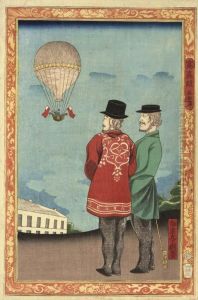Miyazaki Gengyo Paintings
Miyazaki Gengyo was a Japanese artist and woodblock print maker, noted for his contributions to the world of Ukiyo-e, a genre of Japanese art which flourished between the 17th and 19th centuries. Born in 1834, Gengyo's work was part of the late Edo and early Meiji periods, a time of significant transformation in Japan as it opened up to the West and began to modernize. While Gengyo may not be as internationally recognized as some of his contemporaries, his works are highly valued for their artistic quality and historical significance within Japan.
Gengyo's artistic journey was marked by his meticulous attention to detail and his ability to capture the essence of his subjects. His work often depicted traditional Japanese landscapes, the daily lives of the people, and historical tales, which were popular themes in Ukiyo-e art. He was adept at utilizing the nishiki-e technique, a multi-colored woodblock printing method, to create vibrant and detailed prints that were sought after during his time. This technique allowed him to achieve a level of depth and realism that was admired by both his peers and the public.
Despite the changing times and the introduction of photography and Western art forms, Gengyo remained committed to the traditional methods of Ukiyo-e, preserving its techniques and themes even as Japan underwent rapid modernization. His dedication to his craft helped to keep the tradition alive and influenced the generations of artists that followed.
Miyazaki Gengyo's death in 1915 marked the end of an era for the Ukiyo-e genre. However, his legacy lived on, and today, his works are preserved in museums and collections across Japan and the world. They serve as a window into the past, offering insight into the cultural and societal shifts that occurred during one of the most dynamic periods in Japanese history. Gengyo's commitment to his art and his skillful representation of Japanese life and nature have ensured his place in the annals of art history as a significant figure in the Ukiyo-e movement.
